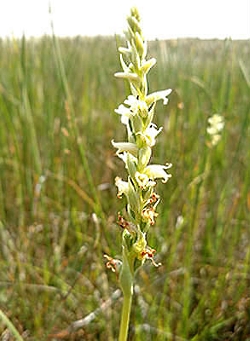
Courtesy U.S. Fish and Wildlife Service
Lindstrom, Photographer
I rejoice at spotting the first white bog orchid or striped coral root as I hike mountain trails. In the Uintah’s you may find the gorgeous Calypso orchid- also called lady slipper, perhaps my favorite. Now, the late season rattlesnake plantain is in full bloom.
Further, I was amazed to find orchids species diversity second only to the composites with orchids hosting 28 thousand species!
Last evening, I joined 8 others with the Bear River Land Conservancy near Mendon to survey a wet meadow for the late blooming Ute Ladies Tresses, a fragile beauty placed on the EPA Threatened Species list in 1992. Shrinking habitat, limited reproduction, over collection, competition from exotic weeds, and herbicides are the main threats. Other threats include impacts from recreation; mowing for hay production, grazing by cattle or horses; hydrology alteration, herbivory by native wildlife (especially meadow voles); reduction in the number and diversity of insect pollinators; drought; and conflicting management with other rare species.
Regarding reproduction, their minute seeds contain little stored food to sustain embryos and are probably short-lived in the soil. Recent attempts to germinate them took up to 1.5 years. It is hypothesized that germinated seedlings must quickly establish a symbiotic relationship with mycorrhizal soil fungi in order to survive. The absence or rarity of appropriate fungal symbionts in the soil may be a major factor limiting the establishment of new Ute ladies’- tresses populations. On a more positive note, under favorable conditions, they have extreme longevity living beyond 50 years.
Bees are their primary pollinators, particularly solitary bees in the genus Anthophora, bumblebees, and occasionally non-native honeybees. Long-term monitoring studies indicate that the relative abundance and composition of the available bee fauna varies from year to year, which may impact overall fruit production rates for the Ladies Tresses.
Orchids have vast cultural connections in art a literature. They are revered as the national flower for several countries and cities. Reading “The Orchid Thief” by Susan Orlean gave me insights into the very lucrative business world surrounding this coveted flower.
For more, visit The Utah Orchid Society and Utah Native Plant Society websites for further information and plan to join them for their frequent outings.
This is Jack Greene reading and writing for Wild About Utah.
Credits:
Images: Courtesy and Copyright
Text: Jack Greene, Bridgerland Audubon Society
Additional Reading:
MOUNTAIN PLANTS OF NORTHEASTERN UTAH, Original booklet and drawings by Berniece A. Andersen and Arthur H. Holmgren, https://forestry.usu.edu/files/uploads/hg506.pdf
https://rockymountainorchids.org/
US Wildflower’s Database of Wildflowers for Utah, https://uswildflowers.com/wfquery.php?State=UT
Spiranthes diluvialis Sheviak (Ute lady’s tresses), USDA Plants Database,
https://plants.usda.gov/core/profile?symbol=EPGI
Spiranthes diluvialis (Ute ladies’-tresses), Lady Bird Johnson Wildflower Center,
https://www.wildflower.org/plants/result.php?id_plant=EPGI
Spiranthes diluvialis, Missouri Botanical Garden, (Temporarily unavailable) https://www.facebook.com/missouribotanicalgarden/posts/pfbid02LUT74wA4PBr45myWNMkbSyaXmb1hUe2bnydmrCMhsKA31sobcZGUAQHrWfPJXq7tl
https://www.efloras.org/florataxon.aspx?flora_id=1&taxon_id=10638
Spiranthes diluvialis, Intermountain Regional Herbarium Network, SEINet,
https://intermountainbiota.org/portal/taxa/index.php?taxon=102217
Ute ladies’-tresses (Spiranthes diluvialis), ECOS Environmental Conservation Online System, USFWS, https://ecos.fws.gov/ecp0/profile/speciesProfile?spcode=Q2WA
Conserving Rare Plants and Private Wetlands in Cache Valley, Thursday, Jun. 02, 2016, https://www.usu.edu/today/?id=55893
Spiranthes diluvialis Sheviak, Streambank Lady’s Tresses, Ute Lady’s Tresses, North American Orchid Conservation Center, https://goorchids.northamericanorchidcenter.org/species/spiranthes/diluvialis/

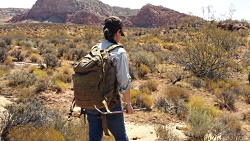
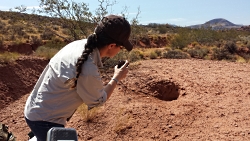
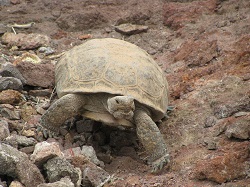
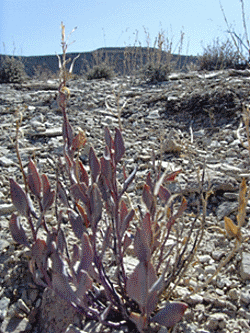
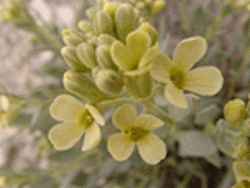

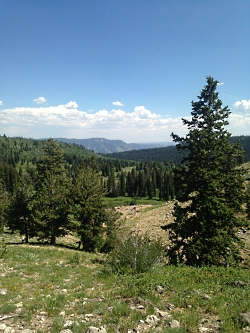
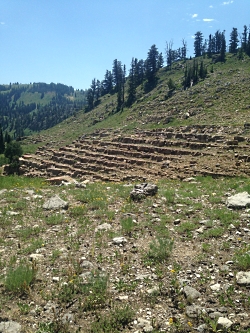 Devil’s Staircase, Tony Grove, Courtesy & Copyright Hilary Shughart
Devil’s Staircase, Tony Grove, Courtesy & Copyright Hilary Shughart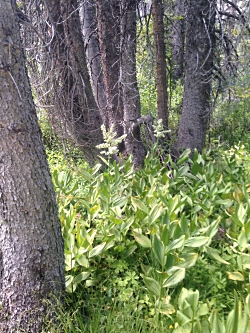 False Hellebore/Corn lily (Veratrum californicum), Tony Grove, Courtesy & Copyright Hilary Shughart
False Hellebore/Corn lily (Veratrum californicum), Tony Grove, Courtesy & Copyright Hilary Shughart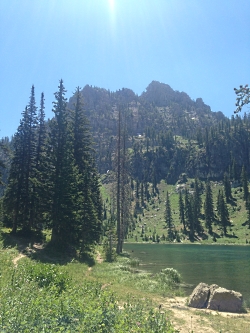 White Pine Lake and Mount Magog, Courtesy & Copyright Hilary Shughart
White Pine Lake and Mount Magog, Courtesy & Copyright Hilary Shughart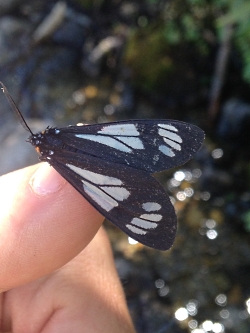 Police Car Moth on Rob Garrett’s thumb, White Pine Lake hike.
Police Car Moth on Rob Garrett’s thumb, White Pine Lake hike.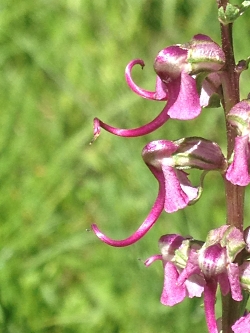 Elephanthead Lousewort (Pedicularis groenlandica), White Pine Lake hike.
Elephanthead Lousewort (Pedicularis groenlandica), White Pine Lake hike.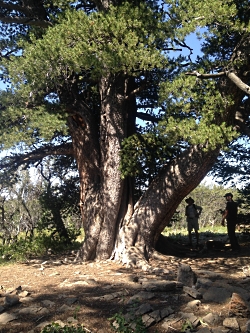 Rob & Jack & big tree, Limber Pine hike
Rob & Jack & big tree, Limber Pine hike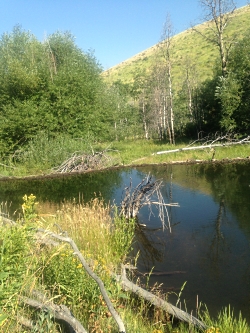 Beaver Dam at USU Forestry Camp (LCFS hike)
Beaver Dam at USU Forestry Camp (LCFS hike) Jack in 560 year old Limber Pine tree 7/27/16
Jack in 560 year old Limber Pine tree 7/27/16